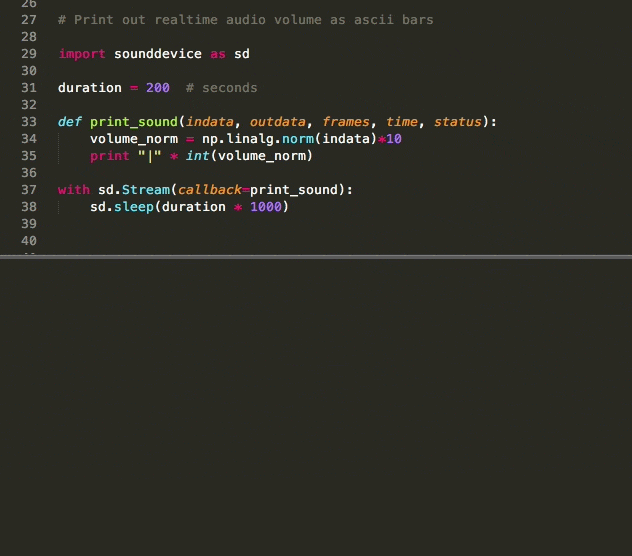I'm trying to read, in near-realtime, the volume coming from the audio of a USB microphone in Python.
I have the pieces, but can't figure out how to put it together.
If I already have a .wav file, I can pretty simply read it using wavefile:
from wavefile import WaveReader with WaveReader("/Users/rmartin/audio.wav") as r: for data in r.read_iter(size=512): left_channel = data[0] volume = np.linalg.norm(left_channel) print volume This works great, but I want to process the audio from the microphone in real-time, not from a file.
So my thought was to use something like ffmpeg to PIPE the real-time output into WaveReader, but my Byte knowledge is somewhat lacking.
import subprocess import numpy as np command = ["/usr/local/bin/ffmpeg", '-f', 'avfoundation', '-i', ':2', '-t', '5', '-ar', '11025', '-ac', '1', '-acodec','aac', '-'] pipe = subprocess.Popen(command, stdout=subprocess.PIPE, bufsize=10**8) stdout_data = pipe.stdout.read() audio_array = np.fromstring(stdout_data, dtype="int16") print audio_array That looks pretty, but it doesn't do much. It fails with a [NULL @ 0x7ff640016600] Unable to find a suitable output format for 'pipe:' error.
I assume this is a fairly simple thing to do given that I only need to check the audio for volume levels.
Anyone know how to accomplish this simply? FFMPEG isn't a requirement, but it does need to work on OSX & Linux.
The python-sounddevice and pyaudio libraries provide ways to record audio with Python. python-sounddevice records to NumPy arrays and pyaudio records to bytes objects. Both of these can be stored as WAV files using the scipy and wave libraries, respectively.
Thanks to @Matthias for the suggestion to use the sounddevice module. It's exactly what I need.
For posterity, here is a working example that prints real-time audio levels to the shell:
# Print out realtime audio volume as ascii bars import sounddevice as sd import numpy as np def print_sound(indata, outdata, frames, time, status): volume_norm = np.linalg.norm(indata)*10 print ("|" * int(volume_norm)) with sd.Stream(callback=print_sound): sd.sleep(10000) 
Python 3 user here
I had few problems to make that work so I used: https://python-sounddevice.readthedocs.io/en/0.3.3/examples.html#plot-microphone-signal-s-in-real-time
And I need to install sudo apt-get install python3-tk for python 3.6 look Tkinter module not found on Ubuntu
Then I modified script:
#!/usr/bin/env python3 import numpy as np import sounddevice as sd duration = 10 #in seconds def audio_callback(indata, frames, time, status): volume_norm = np.linalg.norm(indata) * 10 print("|" * int(volume_norm)) stream = sd.InputStream(callback=audio_callback) with stream: sd.sleep(duration * 1000) And yes it working :)
If you love us? You can donate to us via Paypal or buy me a coffee so we can maintain and grow! Thank you!
Donate Us With